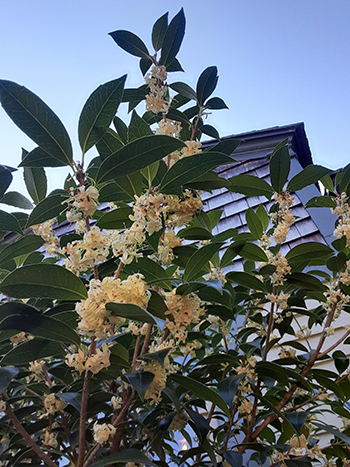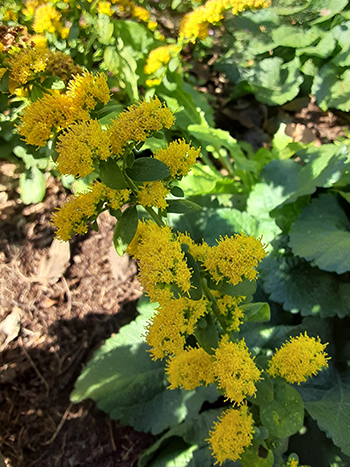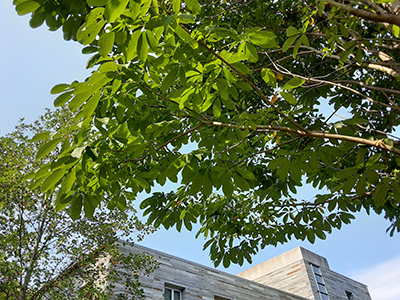
Plants of the Week: October 12

When passing by the Cunningham House or enjoying the Scott Entrance Garden, one will almost surely be struck by an extraordinarily sweet aroma. What is the source of this distinctly tropical smell? Surely it must be one of the many tropical plants in the display of the Scott Entrance Garden; however, this lovely scent can be traced to a rather nondescript holly-like shrub, Osmanthus x fortunei.
A member of the olive family, Oleaceae, O. x fortunei is commonly known as Fortune’s osmanthus, and you would be fortunate to encounter this shrub in flower. A cross between two Asian Osmanthus species, O. fragrans and O. heterophyllus, this plant boasts particularly aromatic flowers. This broadleaf evergreen shrub grows rather large in time, reaching approximately 15’ tall and wide, and can grow up to 25’. Plants are slow-growing and often upright and taller than wide when young. O. x fortunei can be used as a small tree if pruned as such. The shape of O. x fortunei stays neat without pruning making it a good choice in an informal hedge as well. Foliage is quite dense and dark, toothed when juvenile with entire margins at maturity. The foliage, while unremarkable adds a handsome component of a mixed border.
The real draw of O. x fortunei is its fragrant flowering from late September to October. The miniature, white, four-petaled flowers are grouped in clusters at the tips of branches, and while quite insignificant aesthetically, broadcast their lovely aroma across a large area. To me the scent is much like that of apricot or melon. The flowers sprinkle freely, coating the ground in a fashion that I find to be more artful than messy.
O. x fortunei is hardy to zone 7B, so a protected location would be of benefit in the Philadelphia region. This shrub is versatile in terms of growing conditions, and could easily find a home in most gardens. It prefers (like most plants) a moist, fertile, well-drained soil, though O x fortunei is quite drought tolerant, and is less tolerant of wet soils than dry. Site this shrub in shade or sun; shady locations will result in smaller, less dense plants. The value of this shrub stems from the flowers, so place it where the scent can be enjoyed, it’s a treat not to be missed when in bloom!

A plant more likely to catch the attention of one’s eye at this time is Solidago sphacelata ‘Golden Fleece’. Known commonly as autumn goldenrod, this adorable Solidago shines in the autumn, witn outsized impact for its diminutive stature. Boasting an impressive bloom duration from August-October, this 12-18” perennial ties late summer into autumn, filling a vital gap in garden flowering periods.
Goldenrods are beloved members of the autumnal palette for their exuberant golden flowers, but are often weedy in a well-groomed garden. This selection does not proliferate aggressively as many Solidago species do, so you can bulk up your beds with S. ‘Golden Fleece’ without your garden being overtaken. The flowers are borne on multi-branched stems offering an extraordinary density of blooms. Foliage forms neat, dark green rosettes of heart-shaped leaves, attractive as a groundcover prior to the flowering season.
A very tolerant plant, S. sphacelata ‘Golden Fleece’ grows well in poor, clay, and dry soils, though fertile soils are ideal. Plants are drought-tolerant and show impressive disease and deer resistance. Plants thrive in full sun but can tolerate light shade. While S. sphacelata is a species occurring primarily in the Southern U.S., it is very hardy, falling into USDA zone 4.
Consider plantings S. sphacelata ‘Golden Fleece’ among ornamental grasses, meadow plants, or rock garden plants, such as sedum. Given its small size, S. sphacelata ‘Golden Fleece’ needs room to grow and is best used at the front of the border in a garden setting and away from the competition of large perennials. Also consider using in a fall-themed container or as a cut flower where the sturdy, arching stems provide good structure and cheeriness to an arrangement. This plant is growing in the Scott Entrance Garden. Photo credit: R. Payne-Meyer
 One of my favorite genus of trees is Aesculus, often known as buckeye or horsechestnut. These tropical-looking trees have palmately divided leaves and large, showy panicle inflorescences that make them visually unique. However, this genus tends to pale in the fall, with many species susceptible to fungal blight making them lose landscape appeal.
One of my favorite genus of trees is Aesculus, often known as buckeye or horsechestnut. These tropical-looking trees have palmately divided leaves and large, showy panicle inflorescences that make them visually unique. However, this genus tends to pale in the fall, with many species susceptible to fungal blight making them lose landscape appeal.
One Aesculus species which does not fall prey to this unfortunate blight is the Chinese buckeye, Aesculus chinensis. Though rare in cultivation, A. chinensis is certainly deserving of merit, with all the makings for a handsome specimen tree. Like most Aesculus spp., A. chinensis looks its best in late spring, with the emergence of large, showy, cylindrical panicles. Flowers are white and arranged on upright panicles, up to 16” long! This species grows approximately 30-40’ in height and width, making for a great medium-sized shade tree.
Unique, globose, dehiscent (the tendency to split open) capsules form from the fertilized flowers, adding interest in the summer months. From the split capsules, one or two dark nuts with a tan eye can be found; these are the “buckeyes”, from which the name of the chocolate peanut butter treats crafted to resemble these nuts comes. Don’t be tempted to eat these buckeyes though, because unlike the buckeye candies, the nuts of the tree are poisonous!
A. chinensis prefers well-drained soil of medium moisture, and sun to part shade. Growing natively on ravines and roadsides in Northern China, this tree is quite tough and hardy (USDA zone 5), but performs best with consistent soil moisture. When the leaves of A. chinensis do turn color, they boast hues or orange and red, atypical of the muted yellow tones usually seen on Aesculus plants. Look for the display near the Gold Medal Garden. Photo credit: R. Payne-Meyer
How are you designing your garden for fall interest? Consider the above selections to bring beauty and character into your landscape this fall; it may sound cliche but the fall is one the best times for planting!





Wendy Coolen
Posted at 10:07h, 22 OctoberNice suggestions. I am enjoying the bright yellow foliage of clethra, and of course love the fragrance it provides later in the summer.